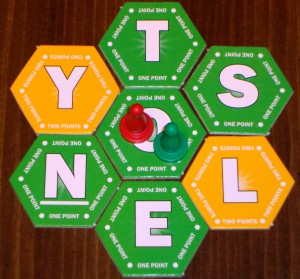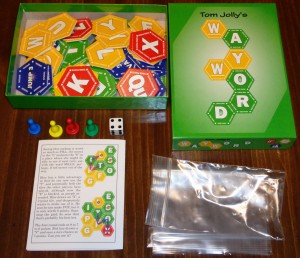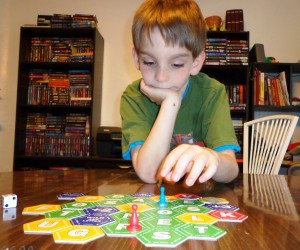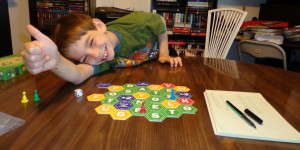Back when I was in college, the Internet and social media were just starting to take off. I am not sure how popular it is today, but I played a Yahoo game called Word Racer a lot. Word Racer featured a Boggle-esque grid in which you had to spell words faster than the other people in your game room. You’d have to form words by using adjacent letters, while scoring bonuses if you used the special letters that randomly showed up each round.
WayWord reminds me of this a bit, without the annoying bots dropping in and out of your room to spam inappropriate links and content. In WayWord, players will be laying letter tiles in an effort to spell words. Before we get started, I’d like to thank Tom Jolly from Jolly Games for sending me a free copy of this game to review. I also had the pleasure of reviewing another game that he recently sent called “Got It!”, feel free to check out that review once you are done here. You can find the full article here:
Components
Tiles – There are seventy-one tiles, which consist of letters and bonuses. Players will notice that the letter tiles are made up of different colors…this is to indicate their individual point values. A green tile is worth one point, a yellow tile is worth two points, and a red tile is worth three points.
Pawns – There are four player pawns (one is assigned to each player) which move around the board as words are spelled out.
Die – This is used to determine who goes first.
Paper and Pencil – (Not Included) You’ll need something to record your scores on as the game progresses. Players will be writing down the words they form, along with their point values.
Setup & Gameplay
First, mix up all of the tiles face down and choose one at random, placing it in the center of the table. Then, draw six more tiles and place them around the starting tile. Finally, select twenty-four (twenty in a two player game) to use for the game, and place the rest back into the box. If any of the starting tiles are red or blue, replace them, and make sure that you have at least two vowels. All players then place their pawns in the center tile. The starting player is chosen randomly.

A normal two player setup. For the record, we used the variant listed in the review section below to make our first game easier.
On a player’s turn, they will draw a tile, place it face up next to an existing tile, and then move their pawn to adjacent letters to spell out a word. They do not start their word with the letter that their pawn was on initially. A letter can be used more than once by coming back to it, and it can be used multiple times before the pawn leaves the tile. A player cannot move through another player’s pawn, so it is possible to strategically block other players as the game progresses. It’s encouraged that players draw a tile right after playing a word so that they have time to think about its placement while others are taking their turns.
There are special tiles that add a certain flare to the game and they do various things. Players can claim these bonuses by moving through them and then on to an adjacent letter. Bonuses can range from adding points to your score to teleporting players around the board. The wild card bonus does not award players any points, no matter what letter is used.
Play continues until all tiles have been used. The scores are tallied and the player with the most points wins!
The Review
Like my experience with “Got It!”, I really like how flexible this game allows you to be. You can add more tiles to the twenty-four you are initially alloted, so as long as it works out that each player would receive an equal amount of turns. If you have four players for example, you could add twenty-eight or thirty-two tiles instead. You can opt to play a longer game, or you can play the standard game which lasts about an hour, sometimes less, depending on how quick players are in forming words. Tom (the game’s designer) posted a variant of the rules on Board Game Geek which assisted in speeding up play, which you can find here: WayWord Variant.
The variant is a welcome addition to the main game and was received well by my son and me. It gave us more options in the beginning, as we were often struggling to find words using the normal setup. The variant also suggests the use of a sand timer (not included in the main game) to help speed things along, which is a good idea if you are pressed for time. I normally leave out timers in the games we review to encourage the kids to think about all of their options.
Since there are seventy-one tiles and you are using less than a third of them in each game, the replay value ends up being extremely high. Add the fact that you have pawns blocking each other’s movements and bonus tiles that provide various effects…two games end up never being the same.
Aside from its replayability, it is very educational. This game forces players to expand their vocabulary and adapt to the letters that they are presented with. This would be an excellent game for kids as it promotes learning and creative thinking. Using this game as a practice aid for spelling and vocabulary in the classroom is very doable. The teacher (or parent) could pick and choose which twenty-four tiles are in the game, based on the kinds of words that they are practicing at the time.
My son struggled at first, not understanding the difference between laying a tile down and starting a word where the pawn was. He quickly came to see after a few turns however that you can strategically place your letter tiles in such a way that your pawn could utilize it. The game went very quickly (about thirty minutes) and we tied at fifty-nine points each. For our first game, I stacked the “deck” with more greens and yellows to help ease him into learning the game. He was trying out different letter combinations and sometimes asked if what he proposed was a word…which is exactly the kind of interaction that I was hoping would result from playing together. He was being encouraged to think outside of the box and expand his vocabulary…a plus for any parent worth his (or her) two cents.
Overall, this is an excellent game to introduce to your family on family game night. Its high replayability allows for hours of fun, while keeping your mind and vocabulary sharp in the process.
Final Verdict: 8/10
You can read more about this game by visiting Jolly Games and Board Game Geek, located here:
—



